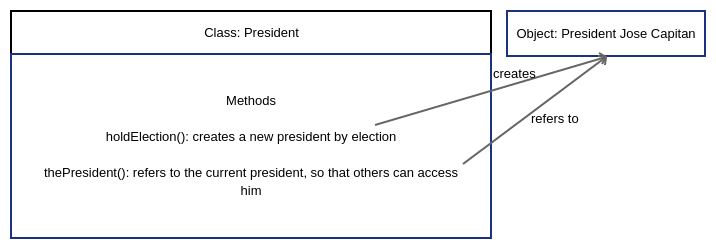In object-oriented programming, design patterns solve challenges that occur in the world of software in the form of recognised patterns. We start with a commonly occurring pattern called the singleton design pattern. You will see equivalent examples from the real world to make things simpler to understand.
An analogy for singleton pattern
Let’s imagine a country named ‘My Native Land’. ‘My Native Land’ is ruled by a single person at the helm. The citizens call him/her the president. Other countries approach this country through him/her. The president is chosen by a public election, from among qualified candidates.
Citizens cannot simply proclaim themselves to be the president at their own will. Nor can they simply appoint their dog, their neighbour, their grocery store owner or their village headman as the president. The only way to choose a president is with a nation-wide election.
There can be only ONE actively serving president at one point in time. The current president gets to remain at the helm until the next election, after which only a victory will get him re-appointed. Otherwise, he/she will have to relinquish the seat to the newly elected candidate.
The designation named president did not exist forever. The role was created at some point in time. Probably when My Native Land embraced democracy. There was NO serving president before that. Someone was appointed for the first time, either through policy or through an inaugural election.
So, what’s the singleton pattern?
Drawing parallels from the presidential example, we should now define the singleton pattern. Here are the features of a singleton pattern.
- There is a class (blueprint) named President. Only one object from the class can be present in the software at a time (similar to only one president for the country analogy). If you need a refresher about classes, objects and instances, please check this post.
- Only one place in the software (like the nation-wide election for a president) can create an object from the class. This place must ensure that only one object created at a time. If there are no objects of the class, then one is created (like the first president when democracy was embraced). Thereafter, if an object needs to be created, it should replace the old one. All references to the old object are lost (the old president stepping down for a new one).
- Barring this single point (election for president), there should be no other way to create an object from the class (e.g. citizens informally crowning themselves or choosing their unqualified neighbour as their president).
- Referring to the class automatically refers to the single instance made out of class. For instance, if a person named Jose Capitan is the current president, then he is simply referred to as ‘The President’ or ‘Mr. President’. This saves the effort of remembering and calling every president by his/her name every time the person in charge changes.
Example of singletons in computer programming
Singletons are commonly used to access your computer’s hardware efficiently. Your phone camera is a good example. What would happen if every app were to create an object of the Camera class and try to access the camera simultaneously, not knowing that other apps also want it? It would be chaos.
Instead, your phone’s operating system dictates the creation of just one Camera object using the Camera class. This object speaks directly to the camera hardware. None of the apps are allowed to create their own Camera objects. They can only refer to the Camera object created by the operating system.
When the phone boots up, there is no Camera object. As soon as the operating system detects your camera hardware, it creates the singleton Camera object for the first time. A new Camera object is only created if the existing camera object crashes or if the user is given a way to switch off the camera hardware and switch it on again. The old Camera object will be deleted and a new one created in its place.
Conclusion
Singleton pattern allows you to safeguard important resources for which a single point must be responsible. It protects you from the chaos that would happen if multiple points try to assume that responsibility.
Further reading
- Book: Head first design patterns (buy on Amazon.in | Amazon.com)
- Blog post: Design Pattern – Singleton Pattern by Tutorials Point
- Blog post: Singleton by Refactoring Guru
- Blog post: Singleton Design Pattern by Source Making

